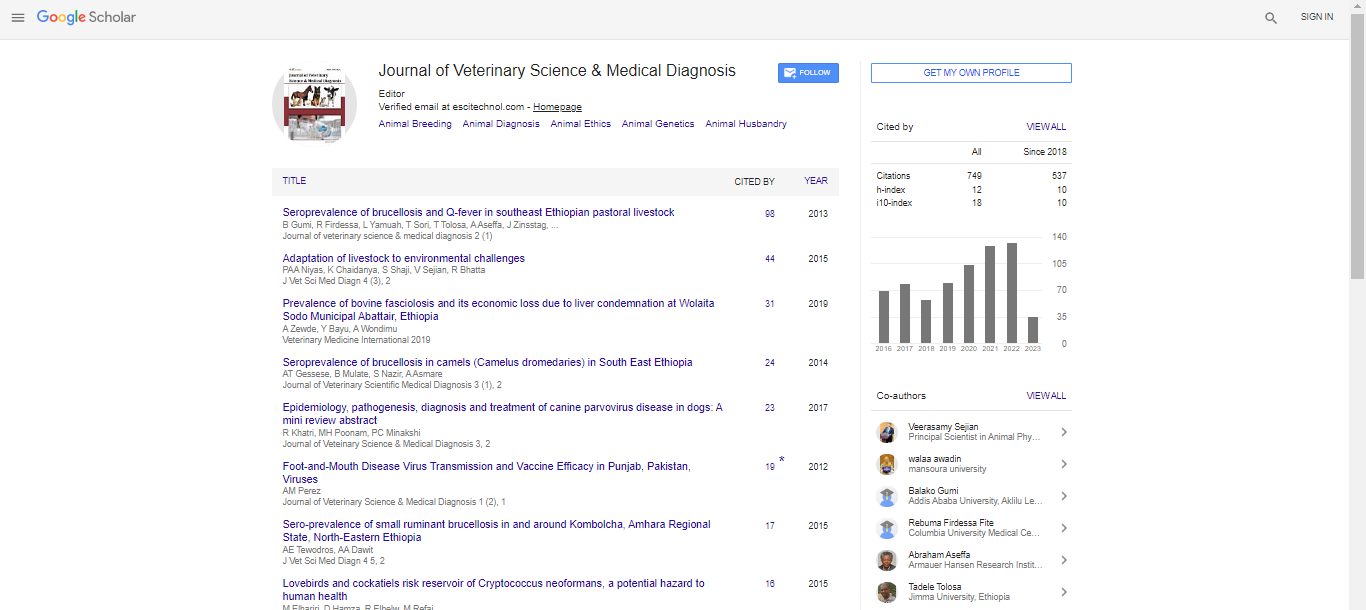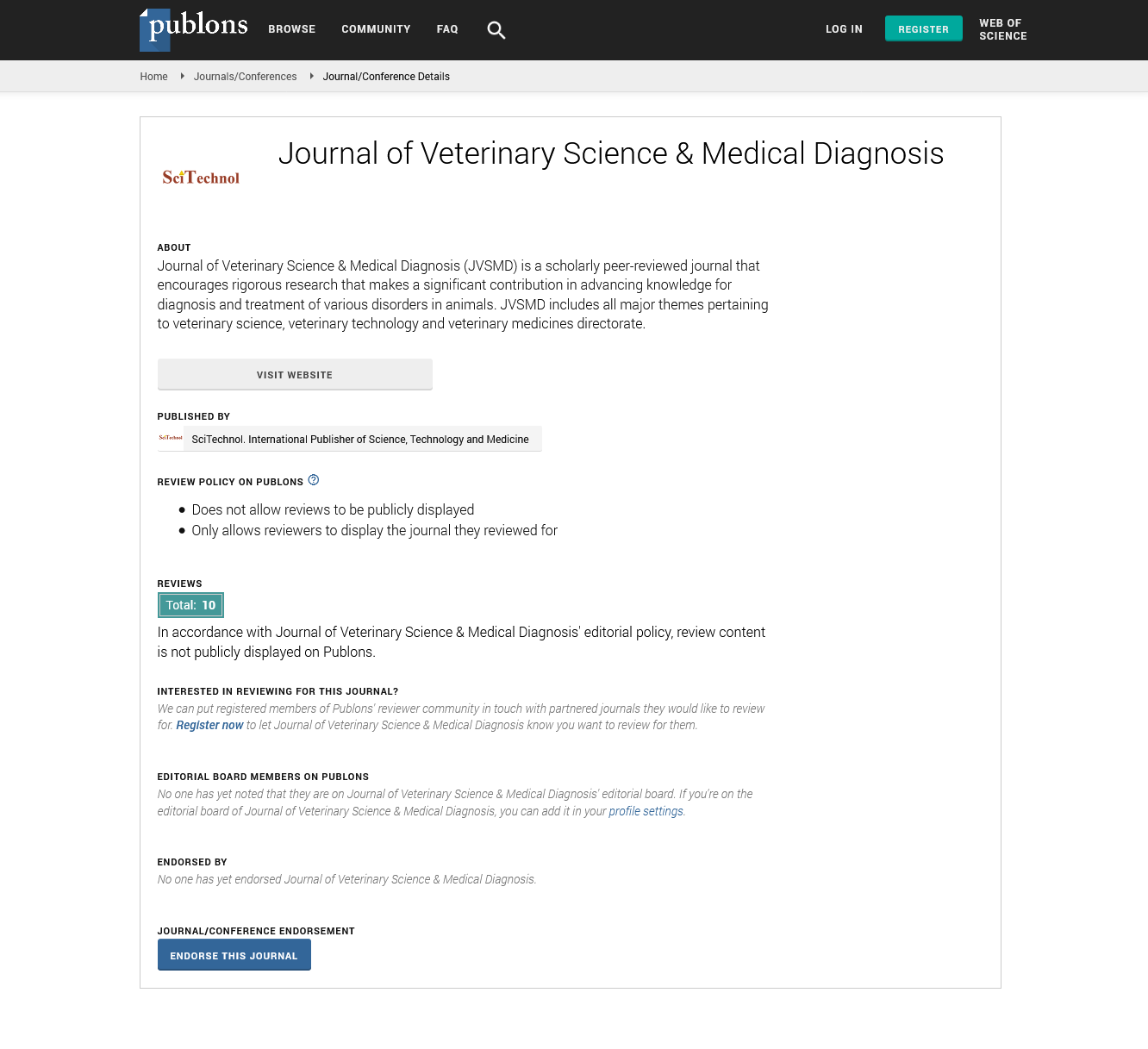Short Communication, J Vet Sci Med Diagn Vol: 13 Issue: 4
Veterinary Technology: Bridging the Gap between Science and Patient Care
Helen. M. Walker*
1Department of Veterinary Science, St Mary’s University, Twickenham, UK
*Corresponding Author: Helen M Walker,
Department of Veterinary Science, St
Mary’s University, Twickenham, UK
E-mail: helenw@gmail.com
Received date: 19 June, 2024, Manuscript No. JEEET-24-144730;
Editor assigned date: 21 June, 2024, Pre QC No. JEEET-24-144730 (PQ);
Reviewed date: 5 July, 2024, QC No. JEEET-24-144730;
Revised date: 12 July, 2024, Manuscript No. JEEET-24-144730 (R);
Published date: 19 July, 2024, DOI: 10.4172/2324-83414.1000108
Citation: Walker HM (2024) Veterinary Technology: Bridging the Gap between Science and Patient Care. J Vet Sci Med Diagn 13:2.
Description
Veterinary technology has revolutionized the way veterinarians diagnose, treat, and manage animal health. As a difficult bridge between scientific advancements and practical patient care, veterinary technology integrates innovative tools and innovations to enhance the efficiency and effectiveness of veterinary practices. This fusion of science and technology has led to significant improvements in diagnostic accuracy, treatment efficacy and overall animal well-being [1].
Advancements in diagnostic tools
One of the most significant impacts of veterinary technology is the advancement of diagnostic tools. Modern imaging technologies, such as digital radiography, Computed Tomography (CT), and Magnetic Resonance Imaging (MRI), have transformed how veterinarians visualize and assess internal structures. These tools offer high-resolution images that allow for detailed examination of organs, bones and tissues, facilitating accurate diagnoses of conditions ranging from fractures to tumors. Digital radiography, in particular, has streamlined the process of obtaining and interpreting X-rays [2].
The digital format allows for immediate image review, enhancing the speed and accuracy of diagnoses. Similarly, CT and MRI provide comprehensive views of complex conditions that are not visible through traditional X-rays, enabling veterinarians to devise more precise treatment plans. In addition to imaging, advancements in laboratory technology have revolutionized diagnostic capabilities. Automated analyzers for blood work, urine tests, and other diagnostics provide rapid and accurate results, allowing veterinarians to diagnose and monitor conditions more efficiently. These technologies also facilitate the detection of subtle changes in health status, enabling early intervention and improving patient outcomes [3].
Enhancing treatment and therapeutic options
Veterinary technology has also expanded the range of treatment options available to veterinarians. Therapeutic technologies, such as laser therapy, regenerative medicine and advanced surgical tools, offer new possibilities for treating a variety of conditions. Laser therapy, for example, provides non-invasive pain relief and promotes healing in soft tissue injuries, while regenerative medicine techniques, such as stem cell therapy, aid in the repair and regeneration of damaged tissues. Advanced surgical tools, including minimally invasive techniques and robotic-assisted surgery, have improved the precision and safety of surgical procedures [4].
These technologies reduce the invasiveness of surgeries, leading to shorter recovery times and less postoperative pain. The integration of surgical navigation systems and real-time imaging during procedures further enhances the accuracy of complex surgeries. Furthermore, veterinary technology has advanced drug delivery systems, such as controlled-release formulations and targeted therapies, which improve the efficacy and safety of medications. Controlled-release systems ensure a consistent level of medication in the body, reducing the need for frequent dosing and improving compliance. Targeted therapies, on the other hand, focus on specific disease pathways, minimizing side effects and maximizing therapeutic benefits [5].
Improving efficiency and patient care
The integration of technology into veterinary practice not only enhances diagnostic and therapeutic capabilities but also improves overall efficiency and patient care. Electronic Health Records (EHRs) and practice management software streamline administrative tasks, allowing veterinarians to focus more on patient care. EHRs facilitate easy access to patient histories, test results and treatment plans, improving coordination and communication within the veterinary team. Telemedicine is another technology that has become increasingly important in veterinary care [6-8].
It enables remote consultations and follow-ups, providing convenience for pet owners and extending access to veterinary expertise. Telemedicine platforms allow veterinarians to assess patients, offer advice, and monitor progress from a distance, making it easier to manage ongoing care and address concerns promptly. In conclusion, veterinary technology serves as a vital link between scientific advancements and practical patient care. By enhancing diagnostic tools, expanding treatment options, and improving efficiency, veterinary technology has transformed the field of animal medicine. These innovations not only support veterinarians in delivering high-quality care but also contribute to better outcomes and improved quality of life for animals. As technology continues to evolve, its role in veterinary medicine will undoubtedly expand, further bridging the gap between science and patient care [9].
References
- Appel MJ, Scott FW, Carmichael LE (1979) Isolation and immunisation studies of a canine parco-like virus from dogs with haemorrhagic enteritis. Veter Rec 105: 156-159.
[Crossref] [Google Scholar] [PubMed]
- Binn LN, Lazer BC, Eddy GA (1970) Recovery and characterization of a minute virus of canines. Infect Immun 1: 503-508.
[Crossref] [Google Scholar] [PubMed]
- Bounavoglia C, Martella V, Pratelli A (2001) Evidence for evolution of canine prvovirus type 2C in Italy. J Gen Virol 82: 3021-3025.
[Crossref] [Google Scholar] [PubMed]
- Tafesse M, Amante M. ( 2019) Prevalence and species identification of ixodid ticks of cattle in Guto Gida district, East Wollega zone, Oromia, Ethiopia. Int J Res Pharm Biosc 6(5):25-34.
- Tafesse M, Amante M. ( 2019) Prevalence and species identification of ixodid ticks of cattle in Guto Gida district, East Wollega zone, Oromia, Ethiopia. Int J Res Pharm Biosc 6(5):25-34.
- Cesar ADP, Telma AM, Dolores UM (2000) Molecular characterization of canine parvovirus in Brazil by polymerase chain reaction assay. Vet Microbiol 75: 127-133.
[Crossref] [Google Scholar] [PubMed
- Cotmore SF, Agbandje-McKenna M, Chiorini JA, Mukha DV, Pintel DJ, et al. (2014) The family Parvoviridae. Archiv Virol 159: 1239-1247.
[Crossref] [Google Scholar] [PubMed]
- Csagola A, Varga S, Lorincz M, Tuboly T (2014) Analysis of the full-length VP2 protein of canine parvoviruses circulating in Hungary. Archiv Virol 159: 2441-2444.
[Crossref] [Google Scholar] [PubMed]
- Decaro N, Cirone F, Desario C (2009) Severe parvovirus in a 12-yearold dog that had been repeatedly vaccinated. Vet Rec 164: 593-595.
[Crossref] [Google Scholar] [PubMed]
 Spanish
Spanish  Chinese
Chinese  Russian
Russian  German
German  French
French  Japanese
Japanese  Portuguese
Portuguese  Hindi
Hindi 
